Direct Shape Optimization and Parametric Analysis of a Vertical Inline Pump via Multi-Objective Particle Swarm Optimization
Abstract
1. Introduction
1.1. Background
1.2. Literature Review
1.3. Paper Organization
2. Computational Model
- : specific speed, rpm;
- : rotation speed of the impeller, rpm;
- : design volume flow rate, m3/s; and,
- : head, m.
3. Numerical Methodology
3.1. Computational Grids
- : gravity coefficient, 9.81 m/s2; and,
- : tangential velocity of impeller outflow, m/s.
3.2. Computational Setup
4. Optimization Process
4.1. Objective Functions
- : the efficiency under 0.5 times design flow rate condition;
- : the efficiency under design flow rate condition;
- : the head of optimized cases under 0.5 times design flow rate condition;
- : the head of the original case under 0.5 times design flow rate condition;
- : the head of optimized cases under design flow rate condition; and,
- : the head of original cases under design flow rate condition.
4.2. Design Variables
4.2.1. Inlet Pipe
- : cross-sectional area;
- : diameter of suction pipe;
- : diameter of impeller inlet;
- : relative position of the cross section; and,
- : design parameters of cross sections (see Figure 8).
4.2.2. Impeller
Blade Shape
Meridional View
Blade Number
4.3. Algorithm Setup
5. Result and Discussion
5.1. Validation Experiment
- : volume flow rate, ;
- : impeller outlet diameter, m;
- : impeller outlet width, m; and,
- : tangential velocity at impeller outlet, m/s.
5.2. Data Mining Analysis
5.3. Pareto Frontiers Analysis
5.4. Performance Comparison
5.5. Hydraulic Head Distribution
6. Conclusions
Author Contributions
Funding
Conflicts of Interest
Nomenclature
| Ax | Area of cross-section, mm2 |
| b1 | Impeller inlet width, mm |
| b2 | Impeller outlet width, mm |
| cx | Length along the mid curve, mm |
| cm | The total length of the mid curve, mm |
| Cp | The pressure coefficient |
| D | Parameter D of cross-section, mm |
| D1 | The diameter of impeller inlet, mm |
| Ds | The diameter of section pipe, mm |
| Dd | The diameter of the delivery pipe, mm |
| H | Pump head, m |
| l | Parameter l of cross-section, mm |
| L | Parameter L of cross-section, mm |
| n | Rotating speed of impeller, rpm |
| ns | Specific speed of the pump, rpm |
| Q | Flow rate, m3/s |
| Qd | The volume flow rate of design flow condition, m3/h |
| u2 | Impeller peripheral velocity at the outlet, m/s |
| xi | Horizonal coordinate of control point i, mm |
| yi | Vertical coordinate of control point i, mm |
| z | Number of blades |
| β1 | Impeller inlet vane angle, degree |
| β2 | Impeller outlet vane angle, degree |
| The efficiency of the pump | |
| Flow coefficient | |
| Head coefficient |
References
- Lazarkiewicz, S.; Troskolanski, A. Impeller Pumps; Pergamon: Oxford, UK, 1965. [Google Scholar]
- Stephen, C.; Yuan, S.; Pei, J.; Gan, X. Numerical Flow Prediction in Inlet Pipe of Vertical Inline Pump. J. Fluids Eng. 2018, 140, 051201. [Google Scholar] [CrossRef]
- Pei, J.; Osman, M.K.; Wang, W.; Yuan, J.; Yin, T.; Appiah, D. Unsteady flow characteristics and cavitation prediction in the double-suction centrifugal pump using a novel approach. Proc. Inst. Mech. Eng. Part A J. Power Energy 2019. [Google Scholar] [CrossRef]
- Wang, W.; Pavesi, G.; Pei, J.; Yuan, S. Transient simulation on closure of wicket gates in a high-head Francis-type reversible turbine operating in pump mode. Renew. Energy 2020, 145, 1817–1830. [Google Scholar] [CrossRef]
- Zhang, Y.; Zhang, Y.; Wu, Y.L. A review of rotating stall in reversible pump turbine. Proc. Inst. Mech. Eng. Part C J. Mech. Eng. Sci. 2017, 231, 1181–1204. [Google Scholar] [CrossRef]
- Pei, J.; Zhang, F.; Appiah, D.; Hu, B.; Yuan, S.; Chen, K.; Asomani, S. Performance prediction based on effects of wrapping angle of a side channel pump. Energies 2019, 12, 139. [Google Scholar] [CrossRef]
- Wang, G.G.; Shan, S. Review of metamodeling techniques in support of engineering design optimization. J. Mech. Des. 2007, 129, 370–380. [Google Scholar] [CrossRef]
- Liu, M.; Tan, L.; Cao, S. Design method of controllable blade angle and orthogonal optimization of pressure rise for a multiphase pump. Energies 2018, 11, 1048. [Google Scholar] [CrossRef]
- Jeon, S.Y.; Yoon, J.Y.; Jang, C.M. Optimal design of a novel ‘s-shape’ impeller blade for a microbubble pump. Energies 2019, 12, 1793. [Google Scholar] [CrossRef]
- Kim, J.H.; Kim, K.Y. Analysis and optimization of a vaned diffuser in a mixed flow pump to improve hydrodynamic performance. J. Fluids Eng. 2012, 134, 071104. [Google Scholar] [CrossRef]
- Kim, J.H.; Choi, J.H.; Kim, K.Y. Design optimization of a centrifugal compressor impeller using radial basis neural network method. In Proceedings of the ASME Turbo Expo 2009: Power for Land, Sea, and Air, American Society of Mechanical Engineers Digital Collection, Orlando, FL, USA, 8–12 June 2009; pp. 443–451. [Google Scholar]
- Derakhshan, S.; Pourmahdavi, M.; Abdolahnejad, E.; Reihani, A.; Ojaghi, A. Numerical shape optimization of a centrifugal pump impeller using artificial bee colony algorithm. Comput. Fluids 2013, 81, 145–151. [Google Scholar] [CrossRef]
- Wang, W.; Osman, M.K.; Pei, J.; Gan, X.; Yin, T. Artificial Neural Networks Approach for a Multi-Objective Cavitation Optimization Design in a Double-Suction Centrifugal Pump. Processes 2019, 7, 246. [Google Scholar] [CrossRef]
- Nourbakhsh, A.; Safikhani, H.; Derakhshan, S. The comparison of multi-objective particle swarm optimization and NSGA II algorithm: Applications in centrifugal pumps. Eng. Optim. 2011, 43, 1095–1113. [Google Scholar] [CrossRef]
- Zhang, J.; Zhu, H.; Yang, C.; Li, Y.; Wei, H. Multi-objective shape optimization of helico-axial multiphase pump impeller based on NSGA-II and ANN. Energy Convers. Manag. 2011, 52, 538–546. [Google Scholar] [CrossRef]
- Takayama, Y.; Watanabe, H. Multi-objective design optimization of a mixed-flow pump. In Proceedings of the ASME 2009 Fluids Engineering Division Summer Meeting, American Society of Mechanical Engineers, Vail, CO, USA, 2–6 August 2009; pp. 371–379. [Google Scholar]
- Benturki, M.; Dizene, R.; Ghenaiet, A. Multi-Objective Optimization of Two-Stage Centrifugal Pump using NSGA-II Algorithm. J. Appl. Fluid Mech. 2018, 11, 929–943. [Google Scholar] [CrossRef]
- Shi, Y.; Eberhart, R.C. Parameter selection in particle swarm optimization. In Proceedings of the International Conference on Evolutionary Programming, San Diego, CA, USA, 25–27 March 1998; Springer: Berlin/Heidelberg, Germany, 1998. [Google Scholar]
- Fourie, P.C.; Groenwold, A.A. The particle swarm optimization algorithm in size and shape optimization. Struct. Multidiscip. Optim. 2002, 23, 259–267. [Google Scholar] [CrossRef]
- Clerc, M.; Kennedy, J. The particle swarm-explosion, stability, and convergence in a multidimensional complex space. IEEE Trans. Evol. Comput. 2002, 6, 58–73. [Google Scholar] [CrossRef]
- Yang, B.; Xu, Q.; He, L.; Zhao, L.H.; Gu, C.G.; Ren, P. A novel global optimization algorithm and its application to airfoil optimization. ASME J. Turbomach. 2015, 137, 041011. [Google Scholar] [CrossRef]
- Chao, D.; Qiu, Z. Particle swarm optimization algorithm based on the idea of simulated annealing. Int. J. Comput. Sci. Netw. Secur. 2006, 6, 152–157. [Google Scholar]
- Wu, X.; Wang, Y.; Zhang, T. An improved GAPSO hybrid programming algorithm. In Proceedings of the International Conference on Information Engineering and Computer Science, Wuhan, China, 19–20 December 2009. [Google Scholar]
- Xie, X.; Wu, P. Research on the optimal combination of ACO parameters based on PSO. In Proceedings of the 2010 International Conference on Networking and Digital Society, Wenzhou, China, 30–31 May 2010. [Google Scholar]
- Safari, A.; Hajikolaei, K.H.; Lemu, H.G.; Wang, G.G. A high-dimensional model representation guided PSOmethodology with application on compressor airfoil shape optimization. In Proceedings of the ASME Turbo Expo 2016: Turbomachinery Technical Conference and Exposition, Seoul, Korea, 13–17 June 2016. [Google Scholar]
- Song, Z.; Liu, B.; Mao, X.; Lu, X. Optimization of tandem blade based on improved particle swarm algorithm. In Proceedings of the ASME Turbo Expo 2016: Turbomachinery Technical Conference and Exposition, Seoul, Korea, 13–17 June 2016. [Google Scholar]
- Pei, J.; Gan, X.; Wang, W.; Yuan, S.; Tang, Y. Multi-objective Shape Optimization on the Inlet Pipe of a Vertical Inline Pump. J. Fluids Eng. 2019, 141, 061108. [Google Scholar] [CrossRef]
- ANSYS. ANSYS CFX User’s Guide, Release; ANSYS: Canonsburg, PA, USA, 2019. [Google Scholar]
- Gülich, J.F. Centrifugal Pumps; Springer: Berlin, Germany, 2008; Volume 2. [Google Scholar]
- Kennedy, J. The particle swarm: Social adaptation of knowledge. In Proceedings of the 1997 IEEE International Conference on Evolutionary Computation (ICEC’97), Indianapolis, IN, USA, 13–16 April 1997. [Google Scholar]
- Eberhart, R.; Kennedy, J. Particle swarm optimization. In Proceedings of the IEEE International Conference on Neural Networks, Indianapolis, IN, USA, 27–30 November 1995; Volume 4. [Google Scholar]
- Shi, Y.; Eberhart, R. A modified particle swarm optimizer. In Proceedings of the 1998 IEEE International Conference on Evolutionary Computation Proceedings. IEEE World Congress on Computational Intelligence (Cat. No. 98TH8360), Anchorage, AK, USA, 4–9 May 1998. [Google Scholar]
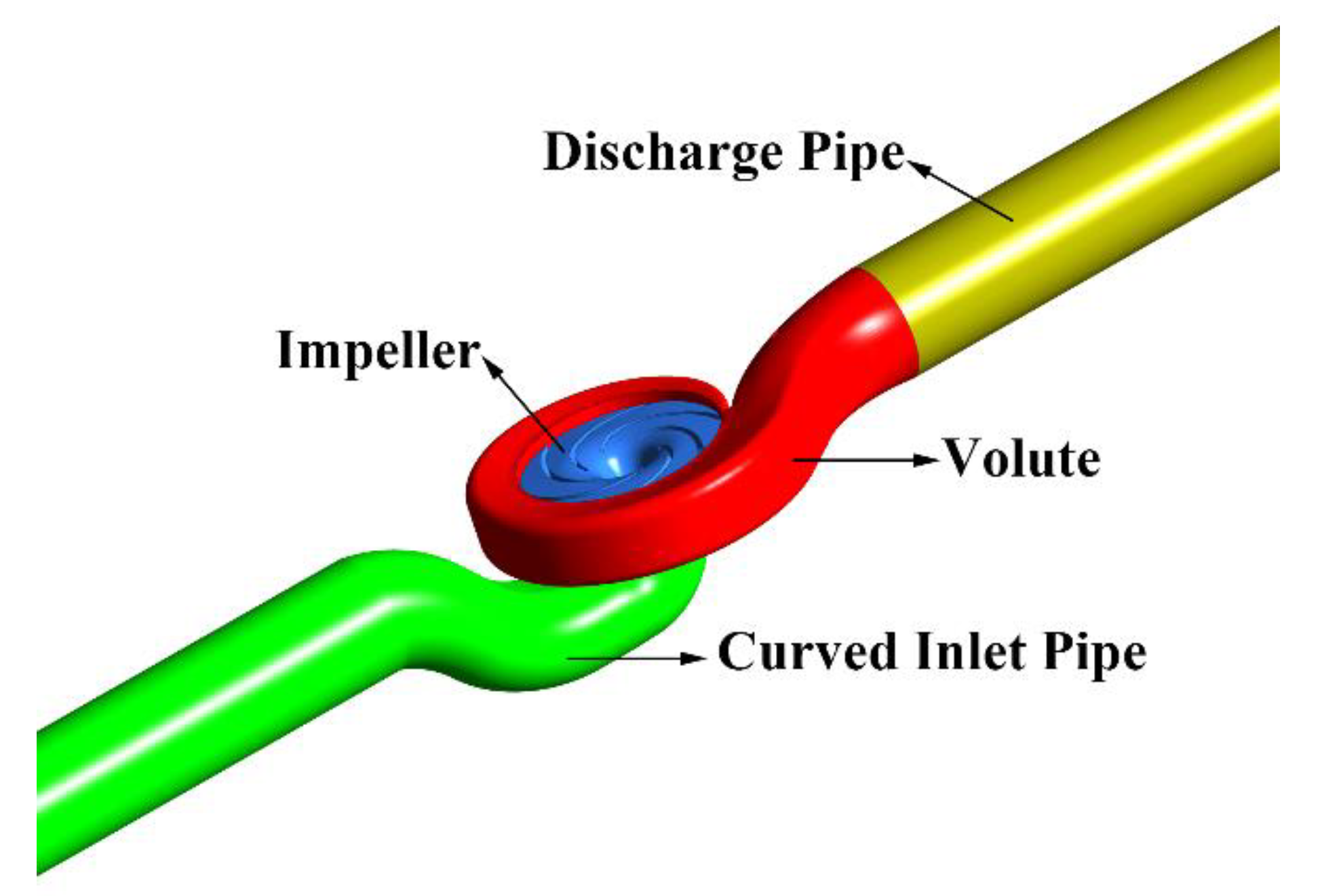
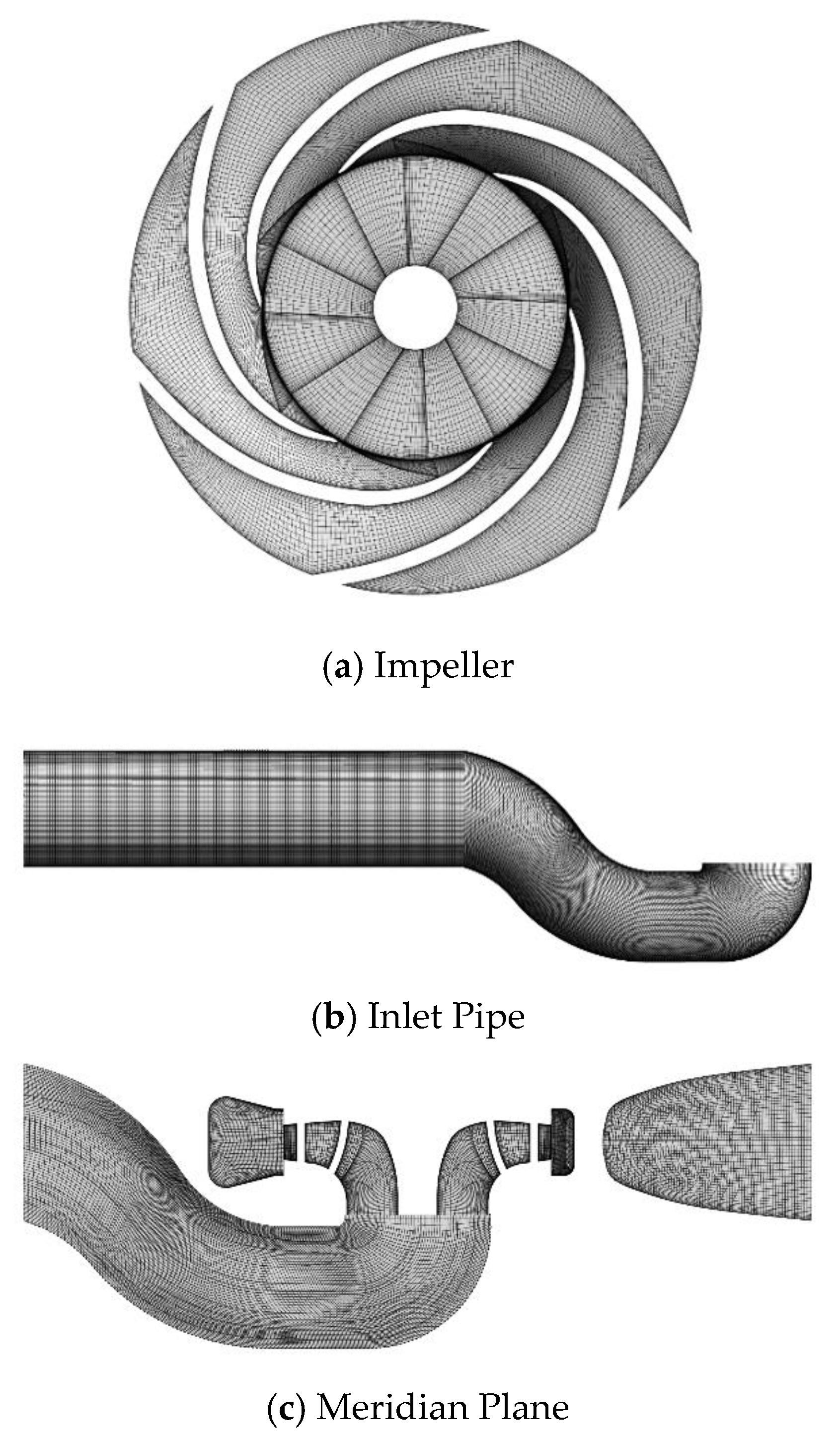

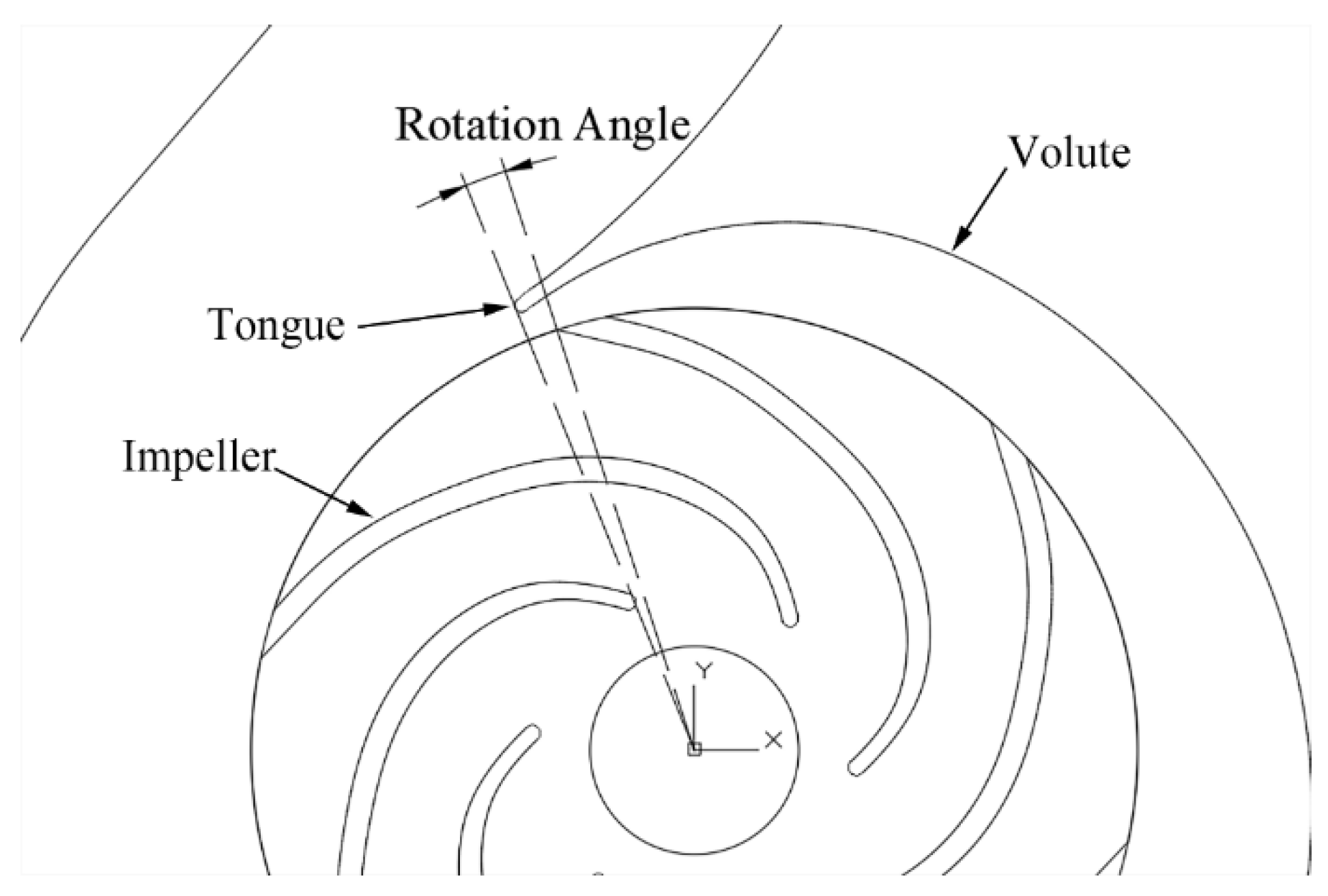
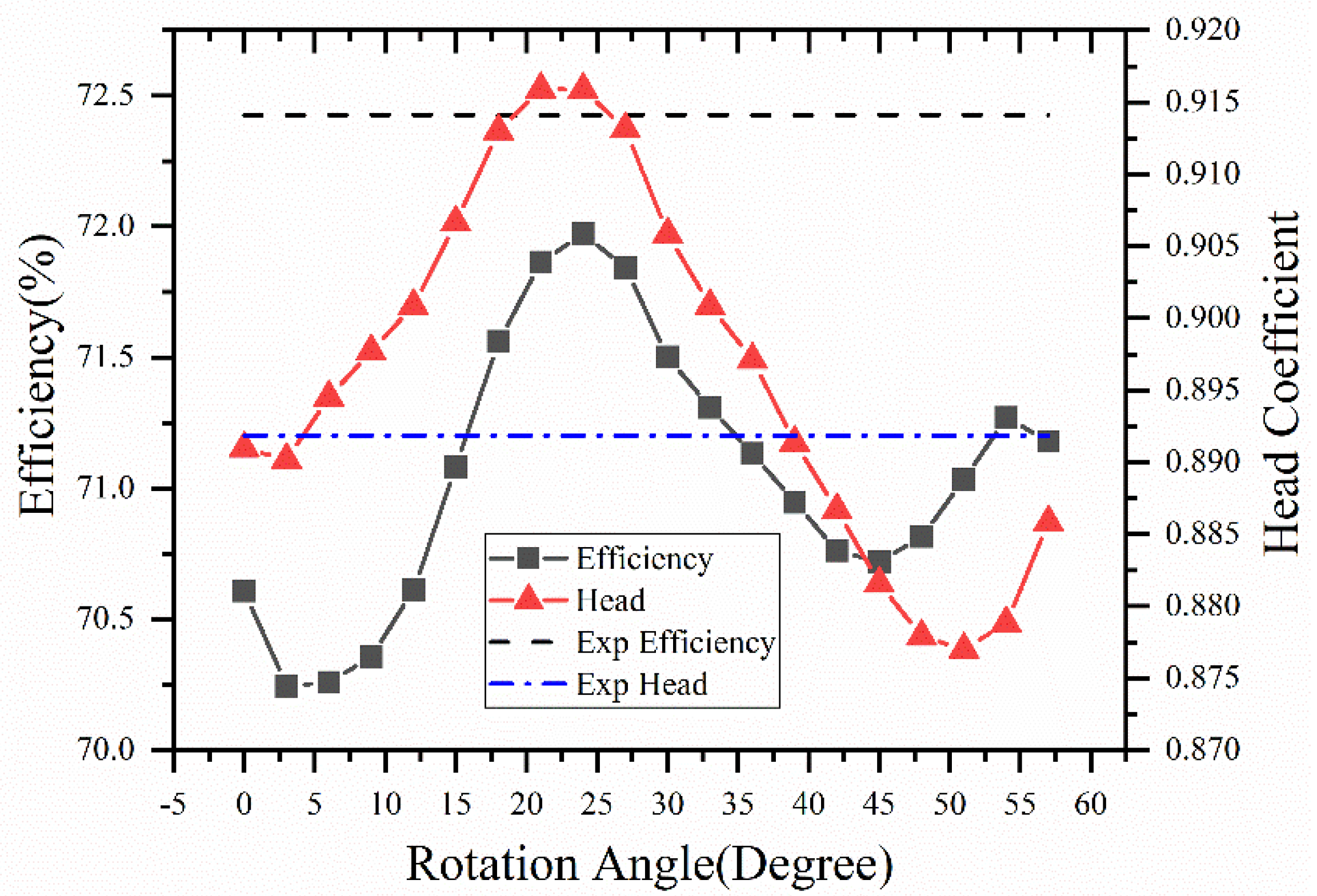
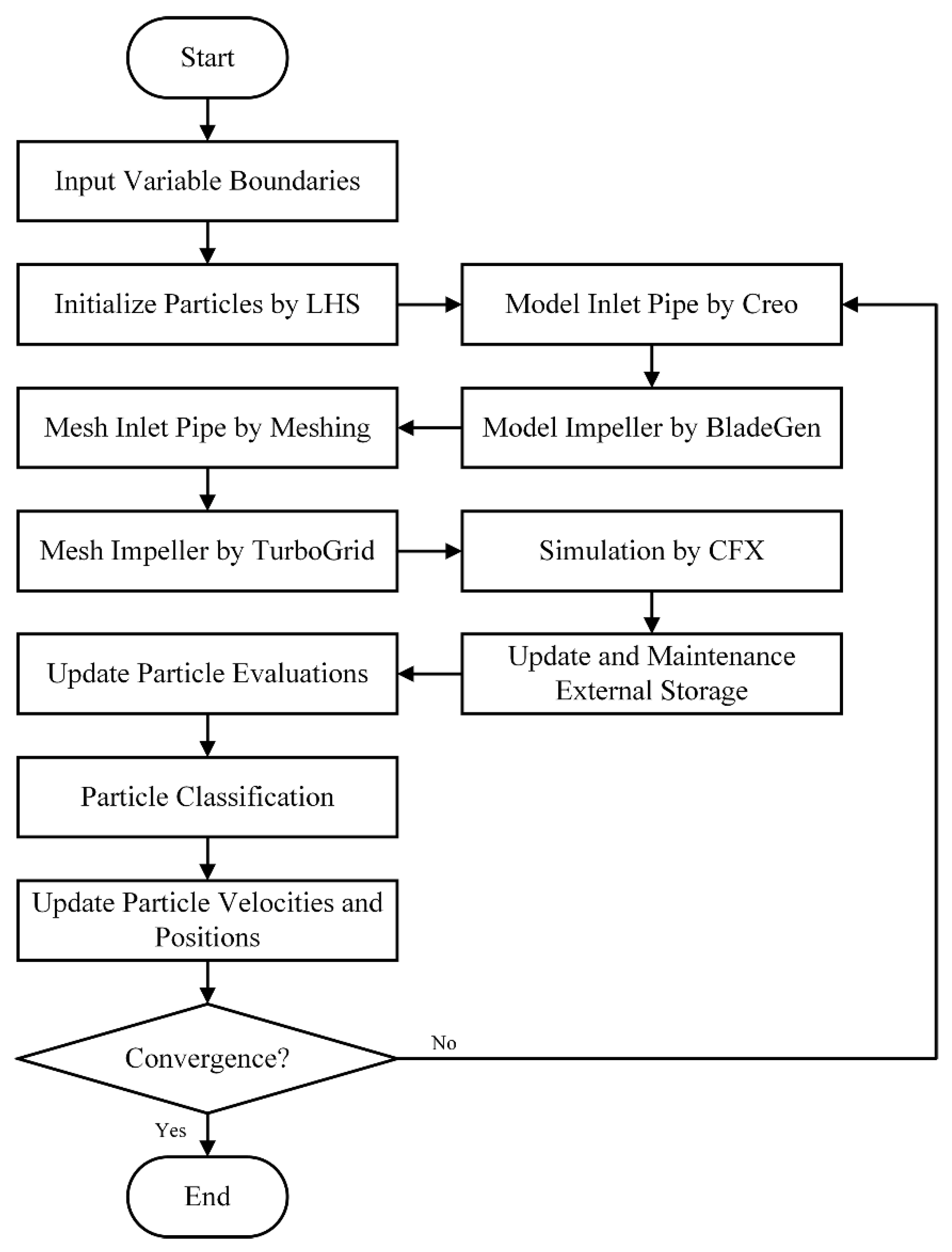
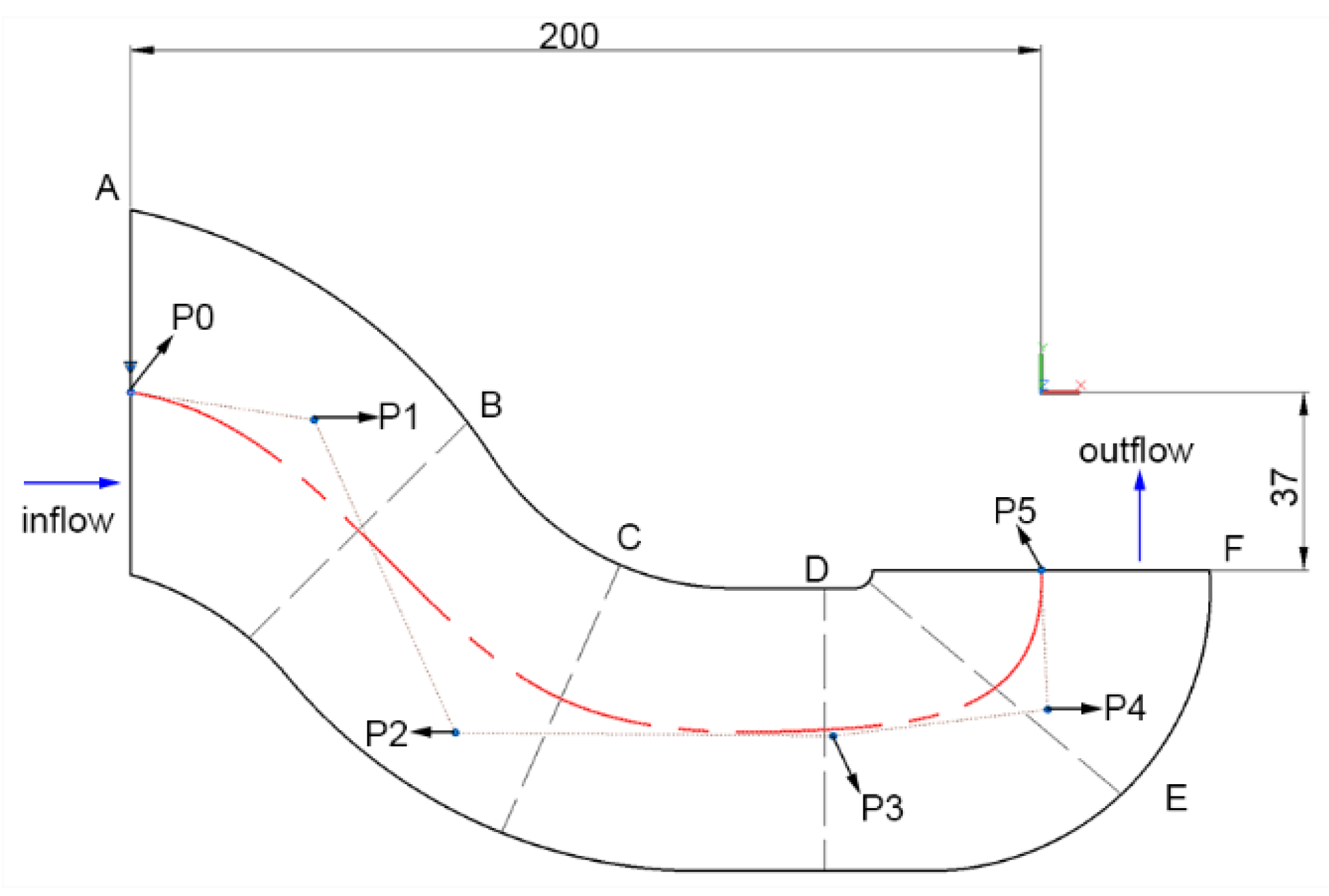

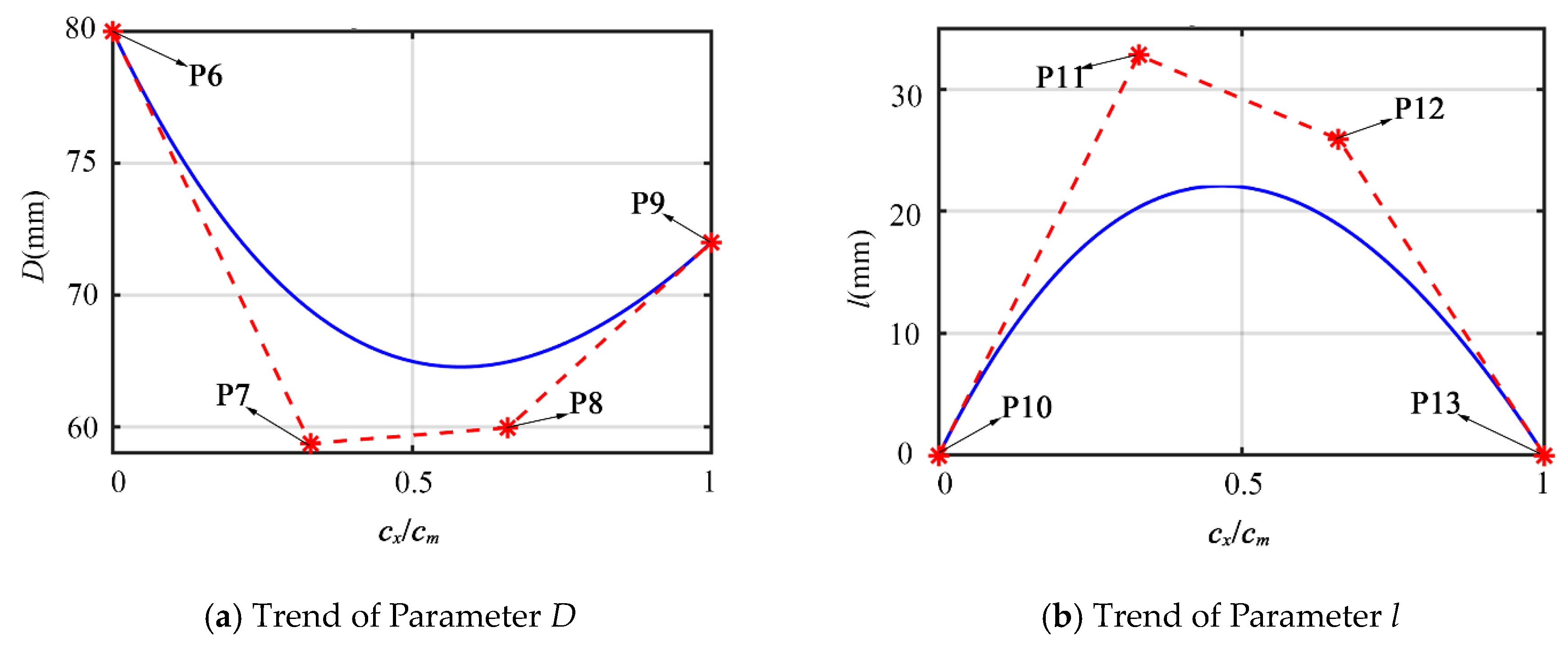
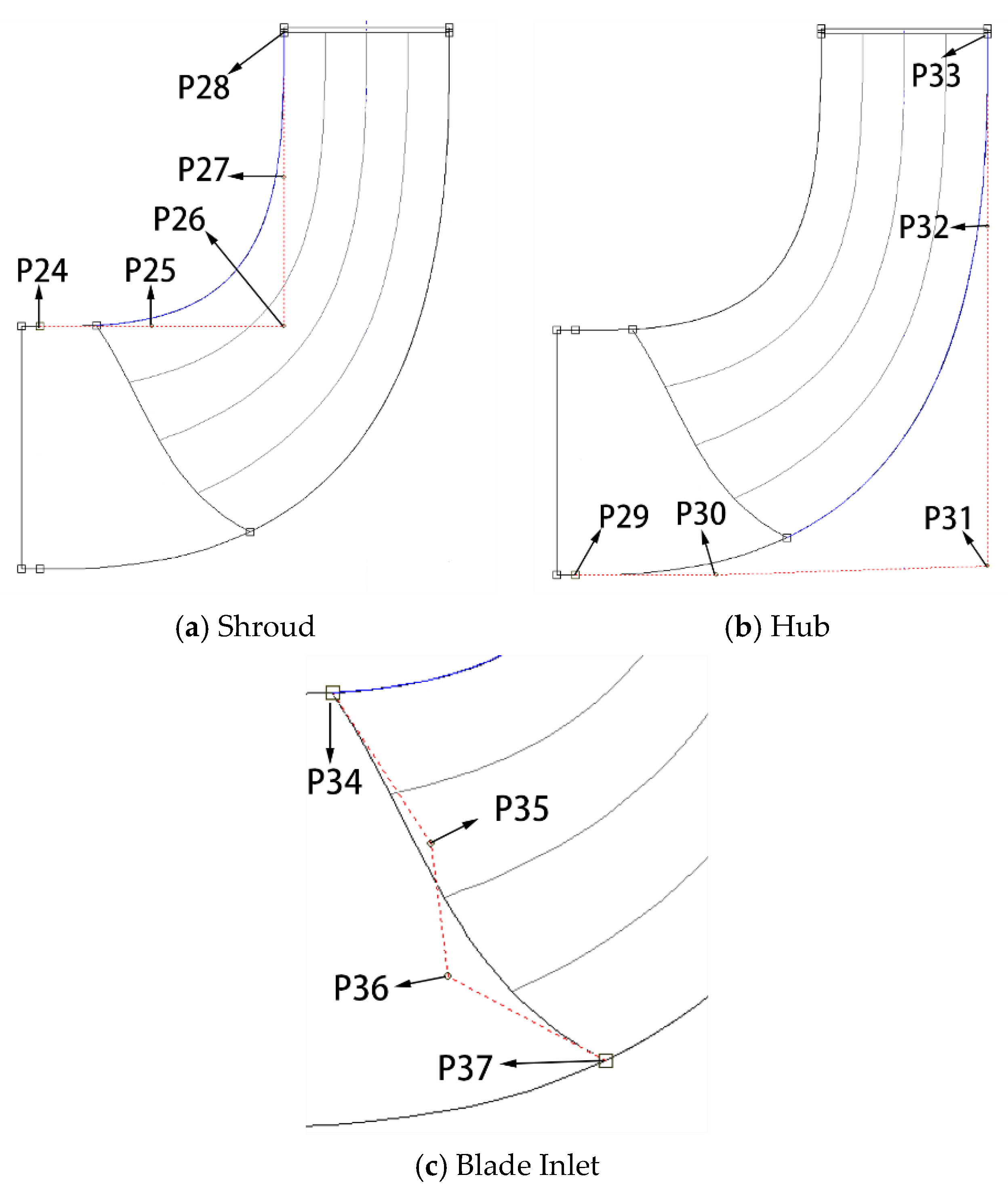
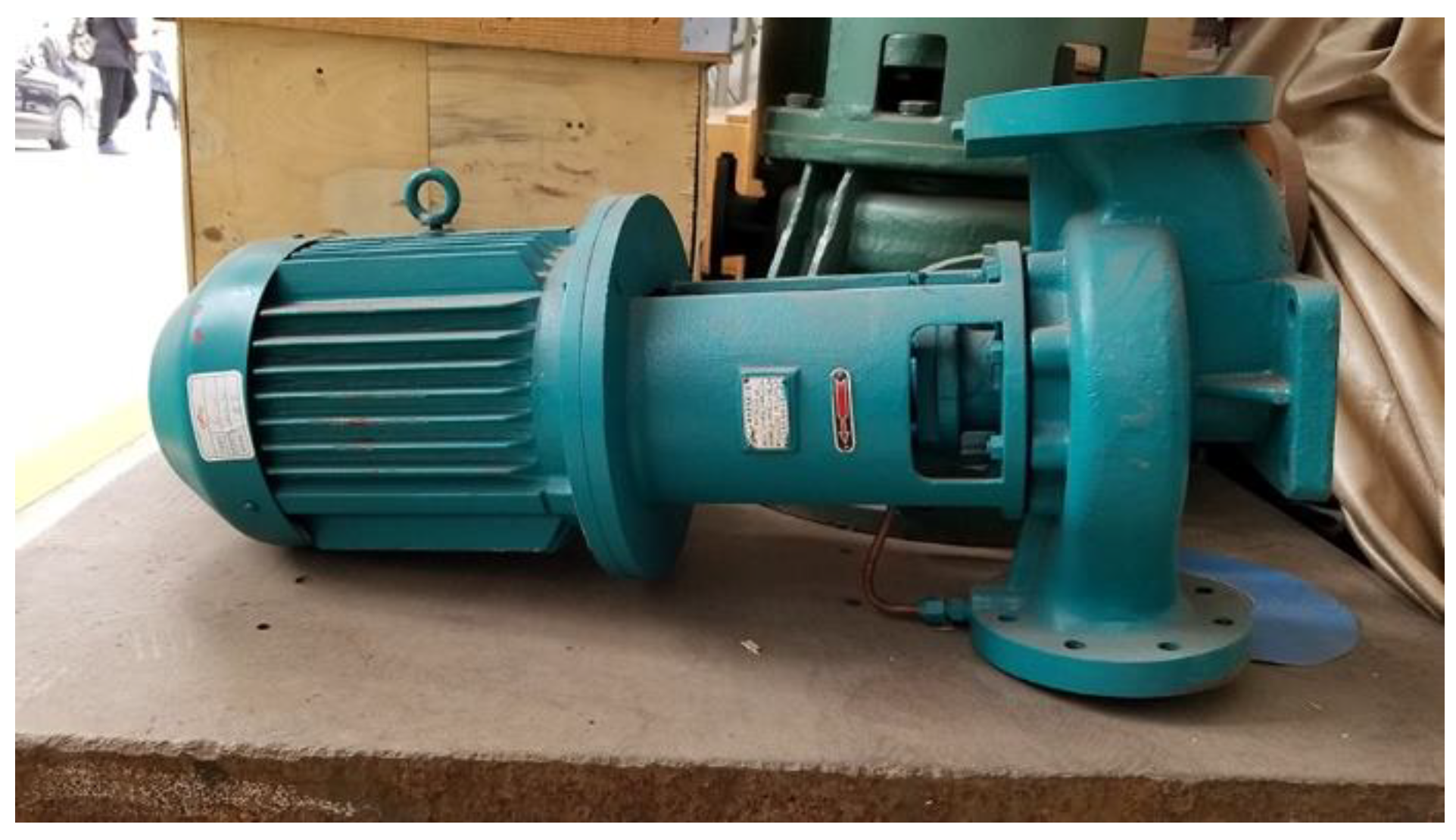
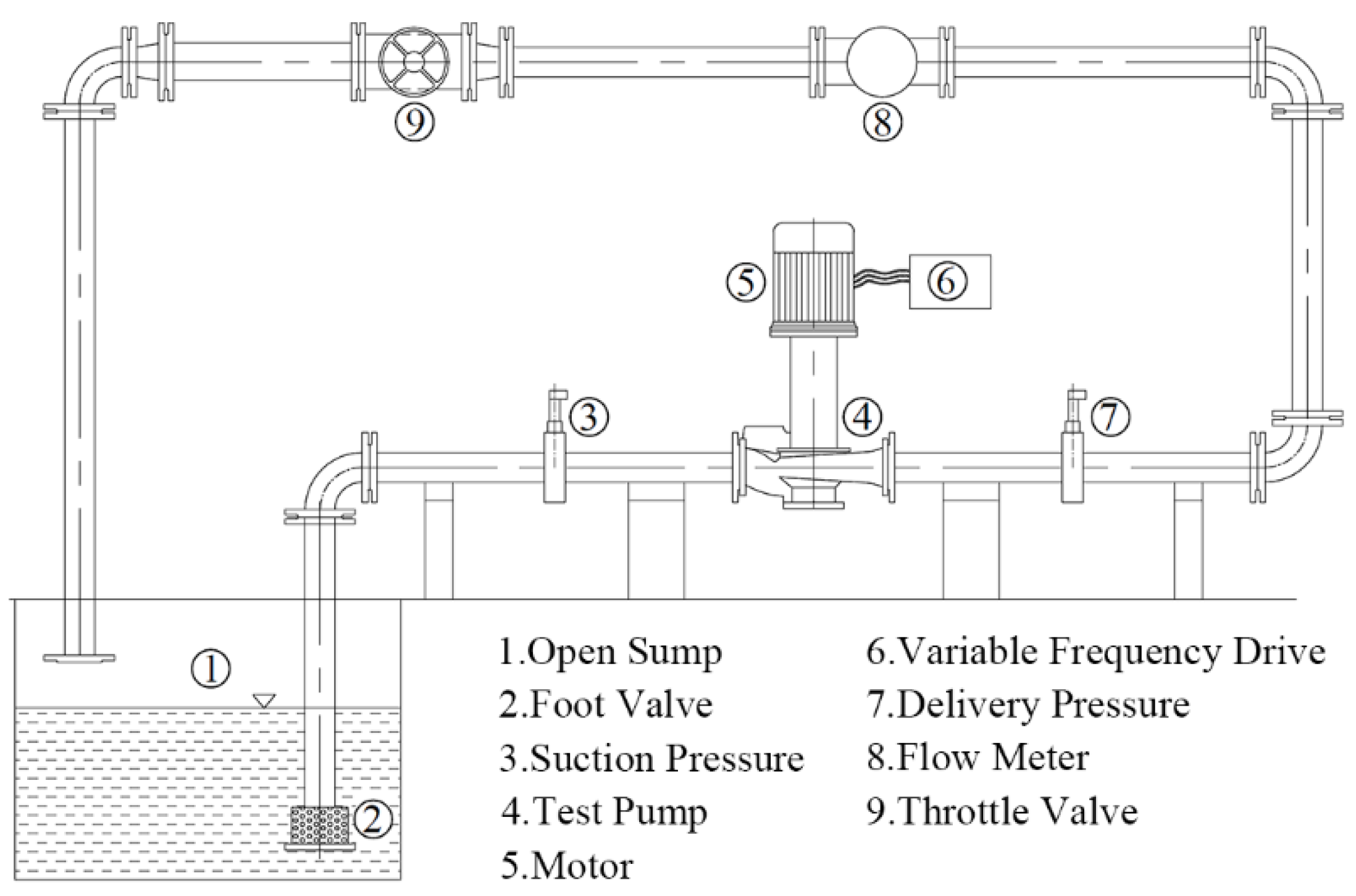
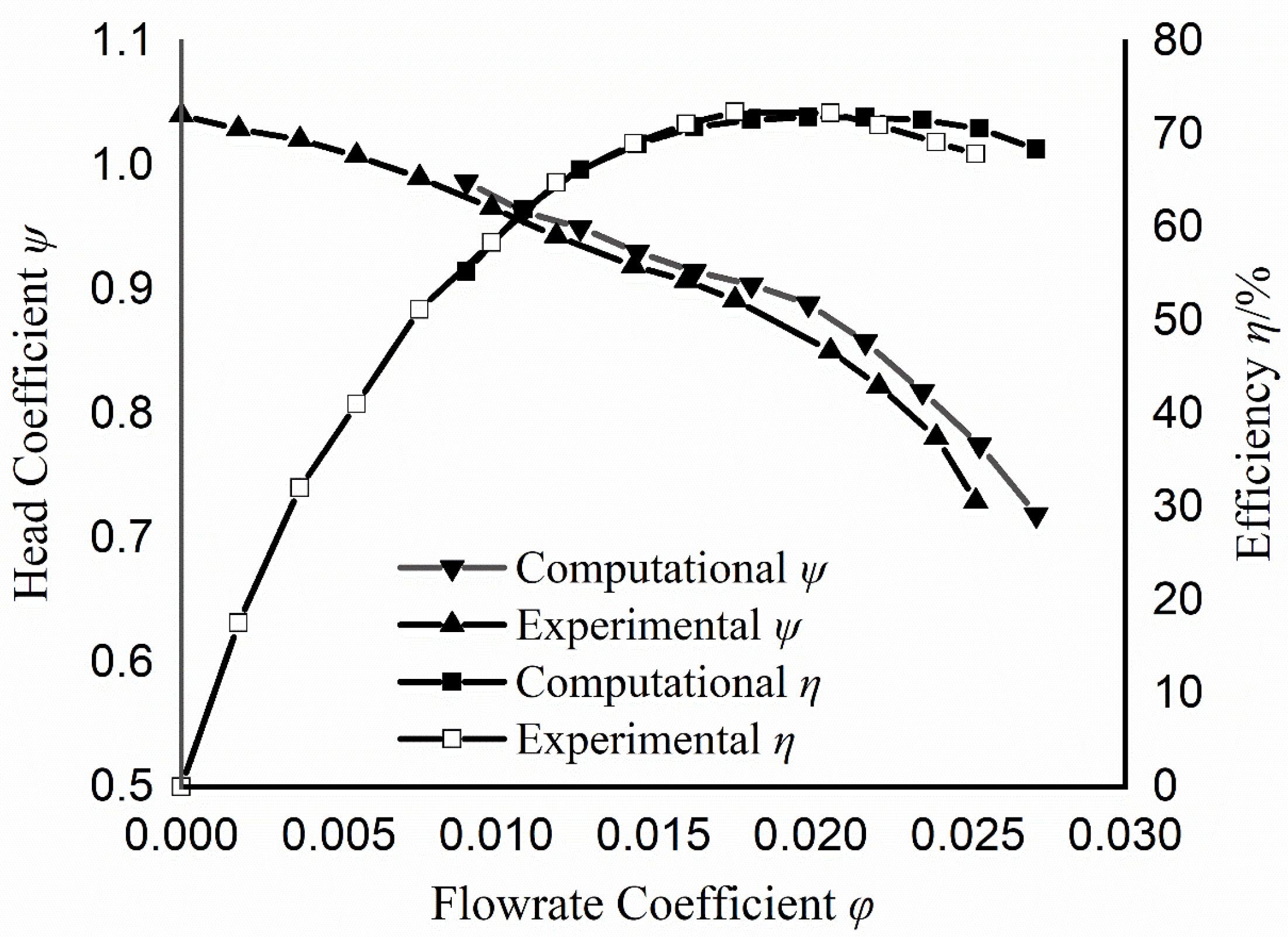

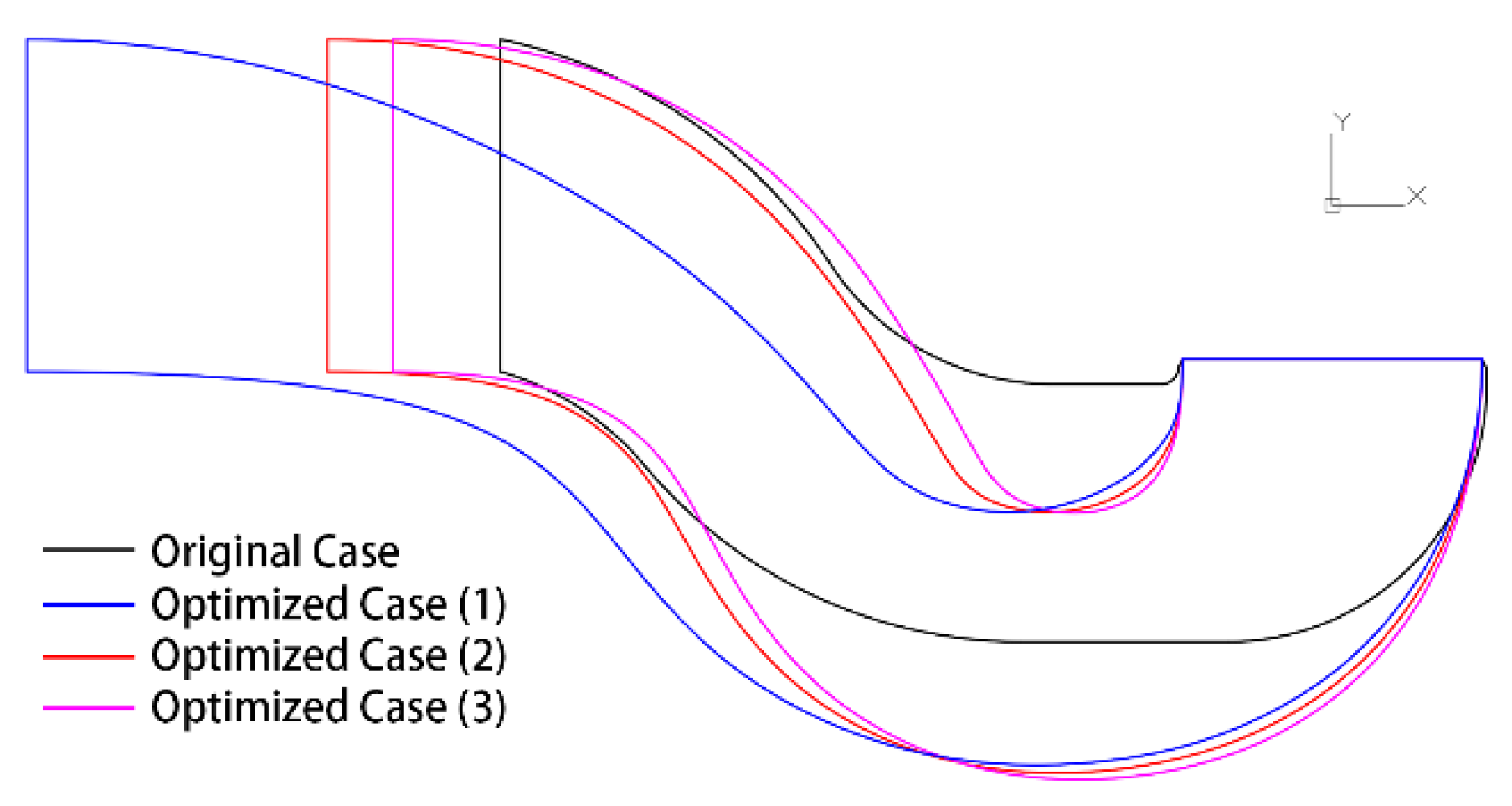
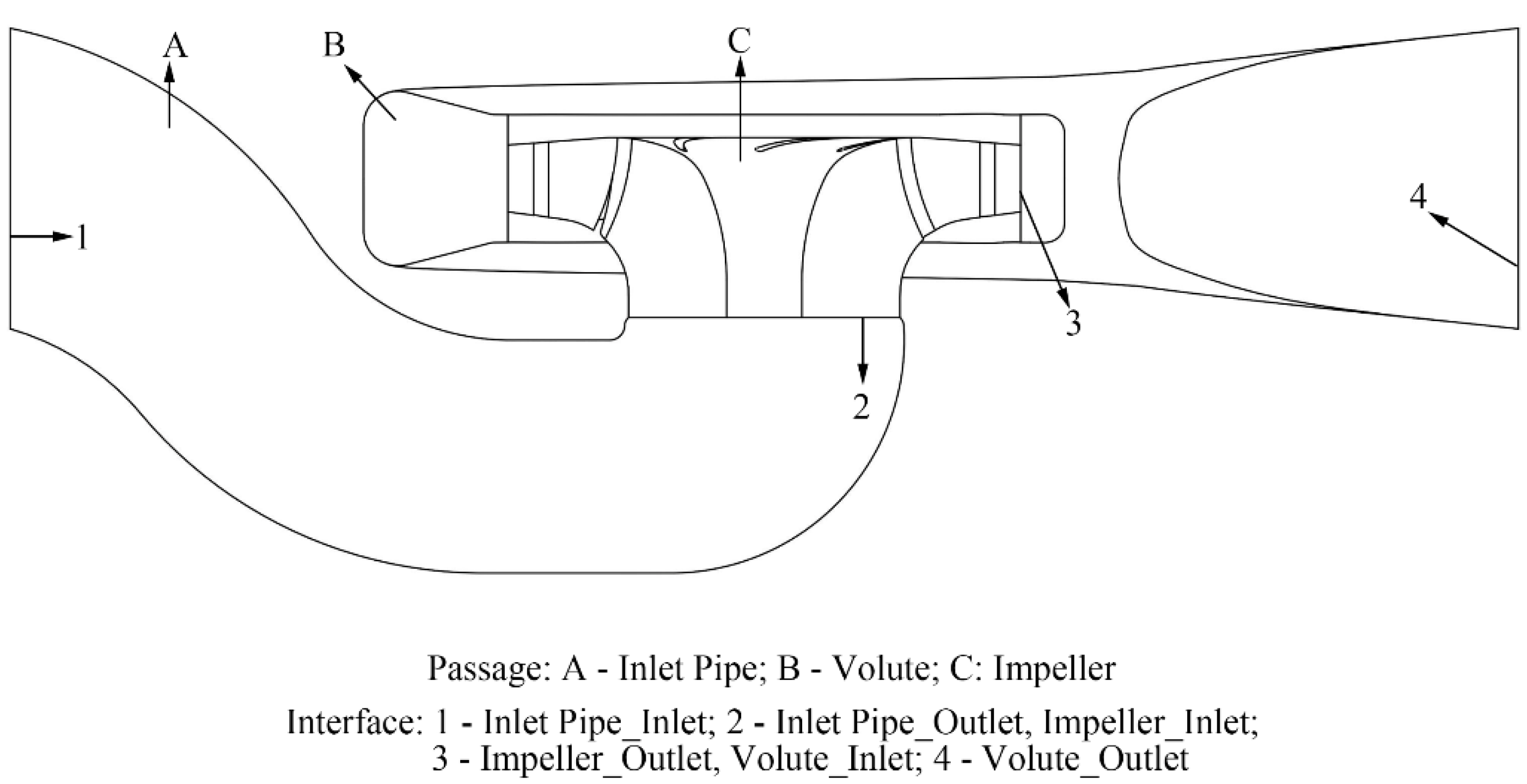
| Parameters | Value |
|---|---|
| Flow rate, Qd (m3/h) | 50 |
| Total head, H (m) | 20 |
| Rotational speed, n (rpm) | 2910 |
| Specific speed, ns (rpm) | 132.36 |
| Impeller inlet diameter, D1 (mm) | 72 |
| Impeller outlet diameter, D2 (mm) | 136 |
| Inlet width, b1 (mm) | 34.5 |
| Outlet width, b2 (mm) | 17.8 |
| Inlet blade angle, β1 (degree) | 38 |
| Outlet blade angle, β2 (degree) | 23 |
| Number of blades, z | 6 |
| Suction pipe diameter, Ds (mm) | 80 |
| Discharge pipe diameter, Dd (mm) | 80 |
| No. | ||||||
|---|---|---|---|---|---|---|
| 1 | 75.30 | 64.55 | 19.65 | 21.13 | 3275.01 | 2085.89 |
| 2 | 75.34 | 64.38 | 19.70 | 21.10 | 3282.28 | 2088.47 |
| 3 | 77.03 | 64.20 | 21.06 | 21.72 | 3431.83 | 2156.40 |
| 4 | 77.04 | 64.18 | 21.06 | 21.72 | 3431.33 | 2156.72 |
| 5 | 77.07 | 63.79 | 21.03 | 21.73 | 3425.45 | 2171.49 |
| 6 | 77.12 | 63.76 | 20.98 | 21.64 | 3414.01 | 2163.20 |
| 7 | 77.46 | 63.49 | 20.48 | 21.34 | 3318.75 | 2142.46 |
| 8 | 77.54 | 63.47 | 20.53 | 21.37 | 3322.16 | 2145.38 |
| 9 | 77.55 | 63.37 | 20.52 | 21.37 | 3321.84 | 2148.76 |
| 10 | 77.92 | 62.68 | 19.84 | 20.78 | 3196.23 | 2112.51 |
| 11 | 77.93 | 62.52 | 19.83 | 20.76 | 3194.08 | 2116.54 |
| 12 | 77.96 | 62.52 | 19.83 | 20.77 | 3191.68 | 2117.46 |
| Original Case | 70.63 | 56.49 | 20.05 | 20.99 | 3466.79 | 2368.08 |
| Parameter | Mid Curve of Inlet Pipe | Blade Angle | Blade Number | |||||||||||||||
|---|---|---|---|---|---|---|---|---|---|---|---|---|---|---|---|---|---|---|
| x0 | x1 | x2 | y2 | x3 | y3 | y4 | y14 | x15 | y15 | x16 | y16 | x17 | y17 | x18 | y18 | y19 | z | |
| 1 | −313.90 | −153.24 | −101.68 | −86.97 | −209.34 | −95.44 | −157.27 | 28.21 | 15.07 | 18.87 | 41.34 | 43.82 | 62.25 | 16.02 | 86.27 | 17.52 | 28.81 | 6 |
| 2 | −313.69 | −153.07 | −101.80 | −87.10 | −209.15 | −95.48 | −157.20 | 28.27 | 15.10 | 19.04 | 41.33 | 43.75 | 62.22 | 16.16 | 86.27 | 17.63 | 28.78 | 6 |
| 3 | −252.70 | −112.81 | −118.62 | −110.39 | −169.20 | −94.75 | −151.06 | 36.01 | 17.17 | 50.04 | 37.66 | 30.26 | 57.70 | 34.58 | 88.22 | 39.35 | 15.79 | 8 |
| 4 | −252.50 | −112.72 | −118.58 | −110.43 | −169.04 | −94.69 | −151.13 | 35.98 | 17.15 | 50.09 | 37.65 | 30.24 | 57.71 | 34.56 | 88.22 | 39.42 | 15.76 | 8 |
| 5 | −259.15 | −115.64 | −120.63 | −109.28 | −174.52 | −97.19 | −148.29 | 37.51 | 17.87 | 48.37 | 37.74 | 30.60 | 57.29 | 35.68 | 88.09 | 36.83 | 16.20 | 8 |
| 6 | −265.11 | −118.80 | −120.89 | −107.70 | −178.57 | −98.34 | −147.40 | 38.26 | 18.15 | 46.04 | 37.98 | 31.55 | 57.24 | 35.55 | 87.99 | 34.58 | 16.92 | 8 |
| 7 | −245.87 | −109.66 | −116.48 | −111.85 | −163.40 | −92.27 | −154.00 | 34.53 | 16.48 | 51.84 | 37.51 | 29.71 | 58.05 | 33.55 | 88.45 | 41.80 | 14.98 | 7 |
| 8 | −241.60 | −107.43 | −115.98 | −112.95 | −160.10 | −91.19 | −155.05 | 34.05 | 16.23 | 53.31 | 37.37 | 29.19 | 58.11 | 33.53 | 88.57 | 43.36 | 14.42 | 7 |
| 9 | −241.79 | −107.53 | −116.03 | −112.90 | −160.26 | −91.26 | −154.98 | 34.09 | 16.24 | 53.25 | 37.37 | 29.21 | 58.10 | 33.55 | 88.57 | 43.29 | 14.44 | 7 |
| 10 | −227.19 | −100.64 | −112.43 | −115.96 | −148.64 | −86.47 | −160.14 | 31.12 | 14.91 | 57.53 | 37.04 | 27.88 | 58.78 | 31.87 | 88.93 | 48.74 | 13.01 | 6 |
| 11 | −227.78 | −100.91 | −112.58 | −115.84 | −149.11 | −86.67 | −159.92 | 31.25 | 14.97 | 57.36 | 37.05 | 27.94 | 58.75 | 31.95 | 88.92 | 48.52 | 13.07 | 6 |
| 12 | −225.92 | −100.03 | −112.12 | −116.24 | −147.61 | −86.06 | −160.59 | 30.88 | 14.80 | 57.90 | 37.01 | 27.77 | 58.83 | 31.74 | 88.97 | 49.21 | 12.87 | 6 |
| Parameter | Mid Curve of Inlet Pipe | Blade Angle | Blade Number | |||||||||||||||
|---|---|---|---|---|---|---|---|---|---|---|---|---|---|---|---|---|---|---|
| x0 | x1 | x2 | y2 | x3 | y3 | y4 | y14 | x15 | y15 | x16 | y16 | x17 | y17 | x18 | y18 | y19 | z | |
| Original Case | −200 | −159.70 | −128.70 | −74.66 | −45.73 | −75.38 | −69.57 | 38 | 20 | 35 | 40 | 32 | 60 | 29 | 80 | 26 | 23 | 6 |
| Optimized Case (1) | −313.90 | −153.24 | −101.68 | −86.97 | −209.34 | −95.44 | −157.27 | 28.21 | 15.07 | 18.87 | 41.34 | 43.82 | 62.25 | 16.02 | 86.27 | 17.52 | 28.81 | 6 |
| Optimized Case (2) | −241.60 | −107.43 | −115.98 | −112.95 | −160.10 | −91.19 | −155.05 | 34.05 | 16.23 | 53.31 | 37.37 | 29.19 | 58.11 | 33.53 | 88.57 | 43.36 | 14.42 | 7 |
| Optimized Case (3) | −225.92 | −100.03 | −112.12 | −116.24 | −147.61 | −86.06 | −160.59 | 30.88 | 14.80 | 57.90 | 37.01 | 27.77 | 58.83 | 31.74 | 88.97 | 49.21 | 12.87 | 6 |
| Parameter | ||||||
|---|---|---|---|---|---|---|
| Original Case | 58.15 | 72.40 | 69.17 | 21.94 | 20.39 | 13.28 |
| Optimized Case (1) | 63.12 | 77.42 | 70.18 | 22.72 | 21.90 | 13.86 |
| Optimized Case (2) | 63.31 | 78.95 | 76.34 | 22.05 | 20.95 | 15.80 |
| Optimized Case (3) | 62.55 | 79.39 | 74.32 | 21.80 | 20.06 | 14.85 |
| Flowrate | Case | Inlet Pipe/m | Impeller/m | Volute/m | Delivery Pipe/m | Input Power/kW |
|---|---|---|---|---|---|---|
| Original Case | −0.817 | 29.004 | −5.882 | −0.111 | 2.368 | |
| Optimized Case (1) | −0.112 | 27.146 | −5.256 | −0.126 | 2.086 | |
| Optimized Case (2) | −0.958 | 27.336 | −4.361 | −0.141 | 2.145 | |
| Optimized Case (3) | −0.893 | 26.645 | −4.275 | −0.135 | 2.117 | |
| Original Case | −0.044 | 22.828 | −2.558 | −0.222 | 3.467 | |
| Optimized Case (1) | −0.071 | 22.433 | −2.194 | −0.188 | 3.275 | |
| Optimized Case (2) | −0.076 | 23.109 | −2.001 | −0.204 | 3.332 | |
| Optimized Case (3) | −0.080 | 22.161 | −1.816 | −0.194 | 3.192 | |
| Original Case | −0.086 | 18.464 | −2.151 | −0.504 | 4.425 | |
| Optimized Case (1) | −0.149 | 16.038 | −2.354 | −0.749 | 3.740 | |
| Optimized Case (2) | −0.160 | 18.992 | −1.937 | −0.633 | 4.176 | |
| Optimized Case (3) | −0.168 | 18.288 | −2.087 | −0.742 | 4.030 |
© 2020 by the authors. Licensee MDPI, Basel, Switzerland. This article is an open access article distributed under the terms and conditions of the Creative Commons Attribution (CC BY) license (http://creativecommons.org/licenses/by/4.0/).
Share and Cite
Gan, X.; Wang, W.; Pei, J.; Yuan, S.; Tang, Y.; Osman, M.K. Direct Shape Optimization and Parametric Analysis of a Vertical Inline Pump via Multi-Objective Particle Swarm Optimization. Energies 2020, 13, 425. https://doi.org/10.3390/en13020425
Gan X, Wang W, Pei J, Yuan S, Tang Y, Osman MK. Direct Shape Optimization and Parametric Analysis of a Vertical Inline Pump via Multi-Objective Particle Swarm Optimization. Energies. 2020; 13(2):425. https://doi.org/10.3390/en13020425
Chicago/Turabian StyleGan, Xingcheng, Wenjie Wang, Ji Pei, Shouqi Yuan, Yajing Tang, and Majeed Koranteng Osman. 2020. "Direct Shape Optimization and Parametric Analysis of a Vertical Inline Pump via Multi-Objective Particle Swarm Optimization" Energies 13, no. 2: 425. https://doi.org/10.3390/en13020425
APA StyleGan, X., Wang, W., Pei, J., Yuan, S., Tang, Y., & Osman, M. K. (2020). Direct Shape Optimization and Parametric Analysis of a Vertical Inline Pump via Multi-Objective Particle Swarm Optimization. Energies, 13(2), 425. https://doi.org/10.3390/en13020425








